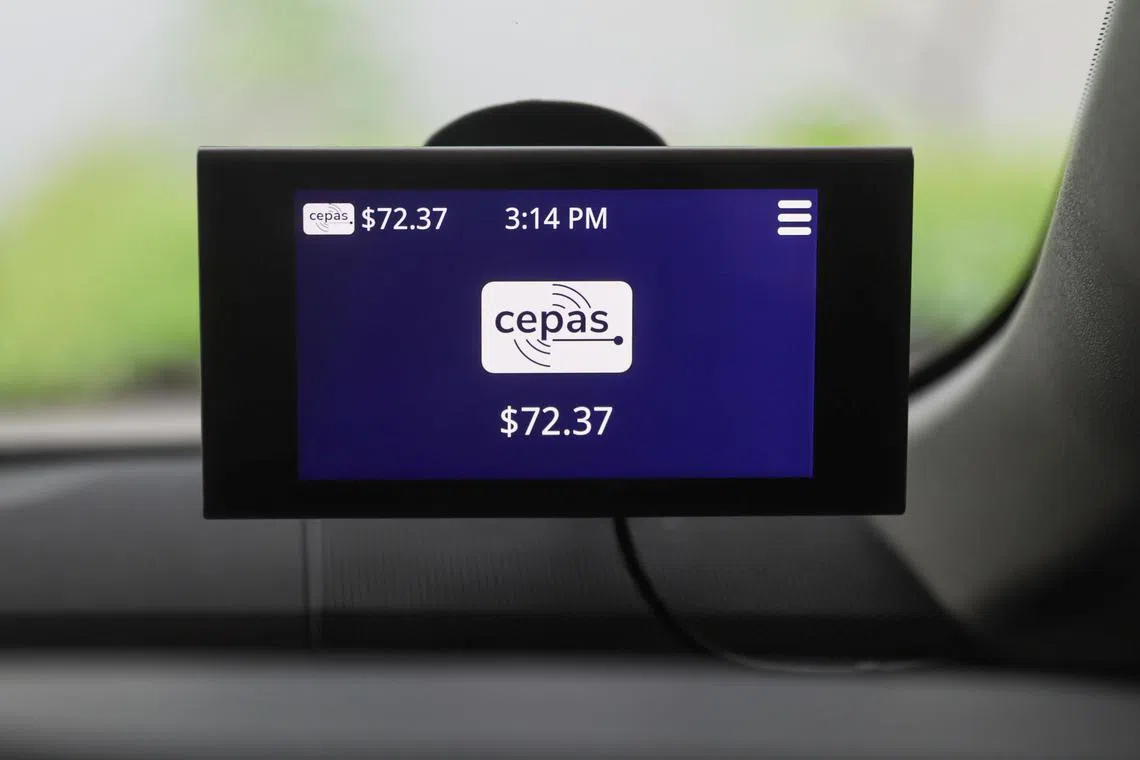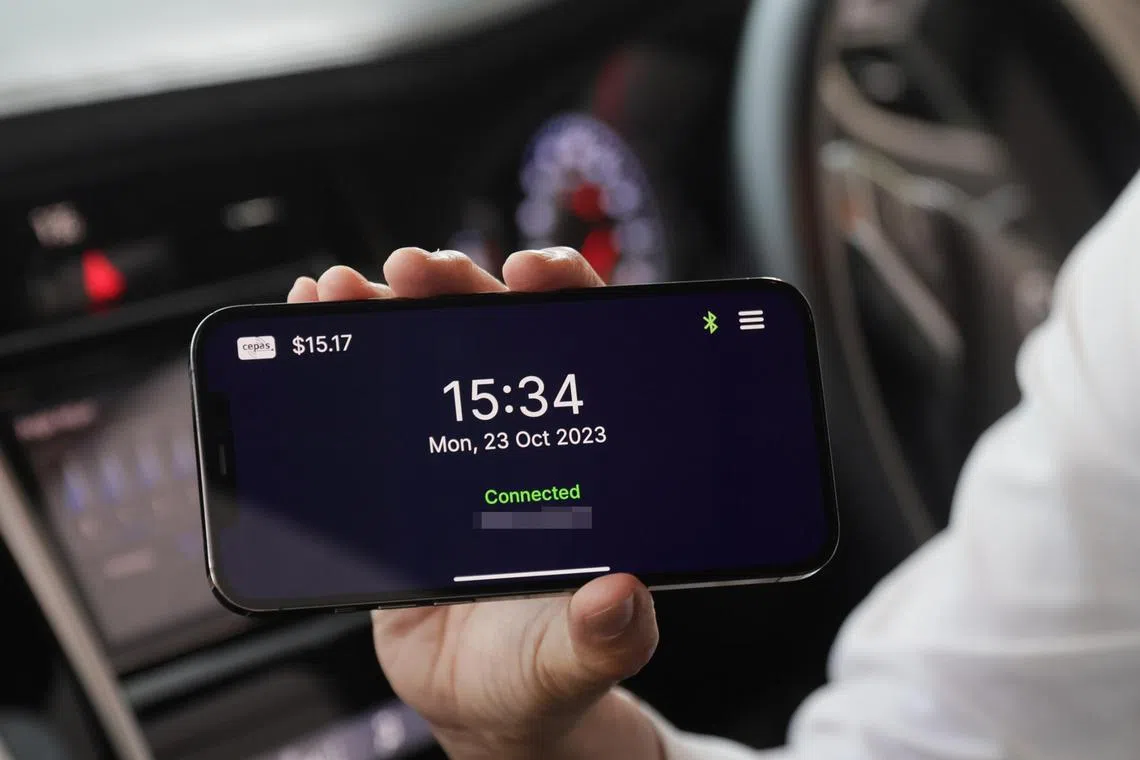Next-gen ERP on-board units to be installed from Nov; motorists can opt out of touchscreen display
Sign up now: Get ST's newsletters delivered to your inbox
Follow topic:
SINGAPORE – On-board units for a satellite-based Electronic Road Pricing (ERP) system will be installed in vehicles in phases from Nov 1 this year, and the exercise is expected to be concluded by the end of 2025.
In all, nearly one million vehicles will be fitted with new on-board units (OBU), starting in November with about 20,000 fleet vehicles – those registered to a company or organisation with 20 or more vehicles. This group includes public buses, fleet motorcycles and taxis, said the Land Transport Authority (LTA) on Monday.
The devices will be installed on new vehicles from the first quarter of 2024, while all other vehicles will have their existing in-vehicle units replaced in batches, based on the vehicle’s age.
In a nod to feedback from the public that the OBU is too bulky,
The new OBU has three pieces – a processing unit located on the side of the front passenger footwell, an antenna and a touchscreen display mounted on the windscreen. Motorcycles will have a single-piece unit mounted on the handlebar.
Vehicle owners will be notified by LTA when it is their turn to install the OBU, with instructions on how to book an appointment.
The OBU will be free if installed within the two-month period stated in the notification, said LTA, adding that it will announce more details about the installation for individual vehicles early next year.
The next-generation ERP system will replace the current 25-year-old cordon-based system, which LTA said is reaching the end of its operational lifespan.
Installation works were slated to start in 2020, but got postponed to 2021 because of the Covid-19 pandemic. This was pushed back again to the second half of 2023 due to a global semiconductor shortage
The LTA spokesperson said the switchover to the satellite-based ERP system will only be announced later, towards the end of the OBU installation exercise.
While the new system can support distance-based charging, LTA said it has “no immediate plans” to start charging motorists based on the distances they clock.
There will be no change to how motorists are currently charged during the transition period, LTA said, without elaborating on how long this would be.
ERP gantries will be gradually removed after the installation period, and LTA is looking into visual markers or signs to clearly indicate ERP charging locations.
The new OBU is compatible with the current ERP systems and carparks. Most of the current payment options for ERP will continue to apply with the OBU. Motorists who use stored value options, like the standard ez-link card or Nets Flashpay and Nets Motoring Card, will have to insert the card into the processing unit.

Backend payment options – EZ-Link Motoring Service and Nets Virtual CashCard – where charges are billed directly to a credit or debit card can also be used.
The LTA said it has been testing the installation and use of the OBUs on a fleet of 500 vehicles since August. They include some vehicles used by Certis Cisco.
Mobile teams will be deployed to install the OBUs at the fleet vehicle owners’ premises. LTA’s spokesperson said this approach “allows workshops to refine and slowly ramp up their processes before the start of mass installation in 2024”.
Currently, it takes around three hours to fit the OBU in a car, and motorcycles will take half as long.

Motorcycles will have a single-piece unit mounted on the handlebar.
ST PHOTO: GIN TAY
As a safety precaution, touchscreen functionalities like adjusting the settings or viewing the transaction history are disabled when a vehicle is travelling at speeds above 15kmh.
LTA said the OBU touchscreen display will provide motorists with information such as ERP locations and charges, their card balance, traffic updates and the locations of silver zones, school zones, speed cameras and bus lanes.
After all vehicles are equipped with the new OBU, there will be additional features such as payment of roadside parking and real-time traffic alerts to inform motorists of road closures, accidents or heavy traffic.
“Motorists are strongly encouraged to install all three OBU components to access the full range of features, such as paying for roadside parking,” said the LTA.

The touchscreen display will provide motorists with information such as ERP locations and charges, their card balance and traffic updates, among other things.
ST PHOTO: GIN TAY
To cater to those who want to use their smartphones to access ERP information, the LTA said it has released a software development kit to allow developers to create mobile apps that integrate and display key ERP data, such as charging and traffic information.
There are strict security safeguards, such as ensuring that apps can receive only ERP information from the OBU but not read other data or make any changes to the data, LTA said.

LTA said motorists will be able to opt out of installing the touchscreen display and get key information via mobile apps on their smartphones.
ST PHOTO: GIN TAY
On why the new ERP system cannot be completely replaced with a smartphone-based payment system, LTA said the OBU has been designed with more robust security measures, and was tested extensively to ensure that it could handle real-time charging transactions and data securely.
The OBU also eliminates other operational issues with a smartphone-based system such as ensuring that the mobile app is working and that the phone has enough power and is connected to the cellular network during the drive, LTA added.
Motorists like Mr Y. Y. Ko are glad to have the option of not having the touchscreen display installed. However, the 46-year-old, who works in the tech industry, asked: “Why not integrate the information into the car’s existing screens like over Apple CarPlay or Android Auto?”


